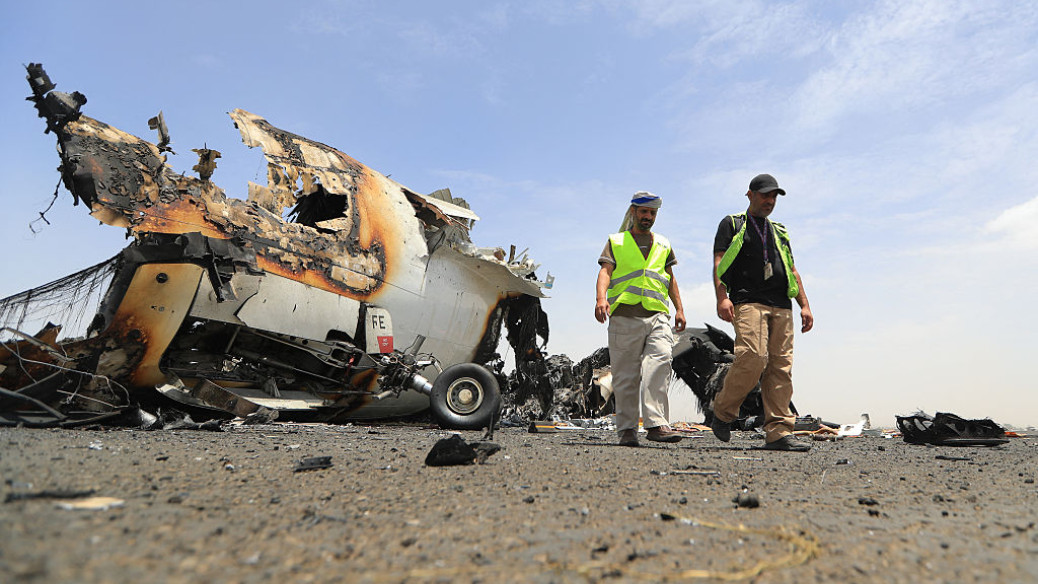Houthi officials said that the Israeli airstrikes destroyed six planes, including three Yemenia aircraft seized during their dispute with the government.
Hundreds of Yemeni travelers are trapped abroad or within the war-torn country after Yemenia Airways canceled all flights to the Houthi-controlled Sana’a airport following Israeli airstrikes that destroyed it.
Officials at Yemenia, the country’s national carrier, said on Wednesday that hundreds of Yemenis are stranded at Queen Alia International Airport in Jordan or in Yemen’s capital. The company suspended its sole flight from the Houthi-controlled Sanaa to Jordan after Israeli warplanes destroyed the infrastructure of Sanaa airport on Tuesday, including its main terminal and the tarmac. “Till now, three flights have been cancelled and each one was supposed to carry 150 passengers,” an official at the Yemenia office, who asked to remain anonymous, in Amman, told The New Arab.
Footage circulated on social media on Wednesday showed dozens of Yemeni passengers, including some sick in wheelchairs, stranded at Queen Alia International Airport in Amman after their flight from the city to Sanaa was cancelled.
The official noted that the company had hosted at least 100 stranded passengers in a hotel at the airport and that they are considering ferrying them to the southern port city of Aden, the base of the internationally recognised government, and then busing them to their homes in Houthi-controlled areas. “90% of passengers are patients, followed by traders and students,” he added.
Posting their images lying on the ground behind their luggage on their social media accounts, stranded Yemenis inside and outside the country have sent appeals to Yemeni authorities for assistance in evacuating them to their destinations. “We ask God for a quick relief and His limitless mercy,” Abdul Latif Al-Zayla’i, a Yemeni YouTuber, said on his Facebook page, lying on his side and resting his head on a black bag on the ground of Amman airport.
The Houthis and the Yemeni government have long vied for control over Yemenia Airways and its resources, part of a fierce competition between the two parties over key institutions in the country.
In June last year, the Houthis seized three Yemenia aircraft at Sanaa airport that were prepared to transport hundreds of Yemeni pilgrims to Saudi Arabia to pressure the Yemeni government to lift its economic sanctions on banks in areas under their control, to cease moving Yemenia’s main headquarters from Sanaa to Aden, and to increase flights from Sanaa airport to new destinations. Following a UN-brokered deal, the Yemeni government agreed to raise the number of flights from Amman from one daily to three and also to lift economic sanctions on banks in Houthi-controlled areas.
Houthi officials noted on Wednesday that the Israeli airstrikes destroyed six planes, including three Yemenia aircraft seized during their dispute with the government.
The Yemeni government operates most of the country’s functioning airports, such as Aden airport, Seiyun airport, Al-Rayyan airport in Hadramout, and other smaller airports.
Yemenis in Houthi-controlled areas have long complained about enduring long and strenuous trips to reach government-controlled areas and have called for the opening of airports in their cities. Since roads are closed during the war, travellers from Sanaa usually take 30 hours to travel from the city to Seiyun airport in Hadramout, a journey that used to take less than 12 hours before the war. Others who are affiliated with the Houthis or those critical of the Yemeni government have also expressed concerns about the risk of being arrested if they travel through government-controlled airports.
Amina Bin Talib, a Yemeni national living in Manchester in the UK, expressed her dismay at the images of burnt planes at Sanaa airport following the Israeli airstrikes, feeling saddened as she was about to be reunited with her mother, who was scheduled to travel through the airport.
After its destruction, her mother and other elderly individuals living near Sanaa airport would have to travel for ten hours to reach another airport.
“This is the picture that upset me the most personally,” she said on her Facebook page, sharing an image of a burnt Yemenia plane. “An elderly person in his seventies must wait in a vehicle or bus for more than 10 hours to get to the closest airport.”

